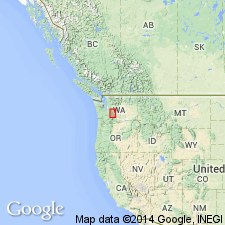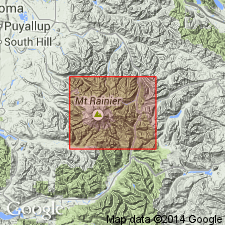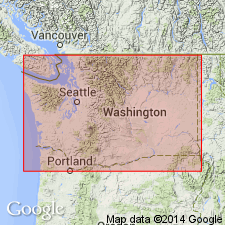
- Usage in publication:
-
- Stevens Ridge formation
- Modifications:
-
- First used
- Dominant lithology:
-
- Rhyodacite
- AAPG geologic province:
-
- Puget Sound province
Summary:
Pg. 39, 48-51, 56. Stevens Ridge formation. Consists almost entirely of rhyodacite ash-flow deposits, with subordinate epiclastic rock toward top. Formation, deposited on surface of considerable relief, reaches thickness of about 3,000 feet in Mount Rainier National Park. Unconformably overlies Ohanapecosh formation (new); concordantly underlies Fifes Peak formation. Name credited to Fiske, Hopson, and Waters (in press) [1963]. Included in Keechelus andesite series by Smith and Calkins (1906). Age is Oligocene or Miocene.
Source: US geologic names lexicon (USGS Bull. 1350, p. 724).

- Usage in publication:
-
- Stevens Ridge Formation*
- Modifications:
-
- Named
- Dominant lithology:
-
- Ash flows
- Volcanic clastics
- AAPG geologic province:
-
- Puget Sound province
Summary:
Pg. 17-25, pl. 1. Stevens Ridge Formation. Formal proposal of name. Consists of ash flows and volcanic clastic rocks. Thickness 450 to about 3,000 feet. Unconformably overlies Ohanapecosh Formation; underlies Fifes Peak Formation, concordant and presumably conformable. Age is Oligocene or Miocene.
Named for Stevens Ridge, a prominent spur just north of Stevens Canyon, in south-central part of Mount Rainier National Park. Crops out at many scattered localities in the park.
Source: US geologic names lexicon (USGS Bull. 1350, p. 724).

- Usage in publication:
-
- Stevens Ridge Rhyodacite
- Modifications:
-
- Overview
- AAPG geologic province:
-
- Puget Sound province[?]
Summary:
Pg. 2869. Stevens Ridge Rhyodacite. Mount Catharine Tuff and its correlative, Stevens Ridge Rhyodacite, rest unconformably upon pre-Tertiary crystalline rocks and upon Puget Group, Ohanapecosh and Guye Formations.
Source: US geologic names lexicon (USGS Bull. 1350, p. 724).
For more information, please contact Nancy Stamm, Geologic Names Committee Secretary.
Asterisk (*) indicates published by U.S. Geological Survey authors.
"No current usage" (†) implies that a name has been abandoned or has fallen into disuse. Former usage and, if known, replacement name given in parentheses ( ).
Slash (/) indicates name conflicts with nomenclatural guidelines (CSN, 1933; ACSN, 1961, 1970; NACSN, 1983, 2005, 2021). May be explained within brackets ([ ]).

